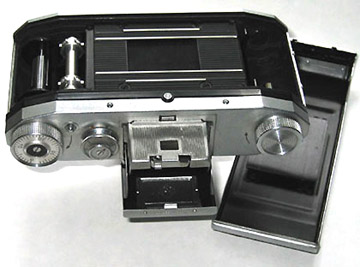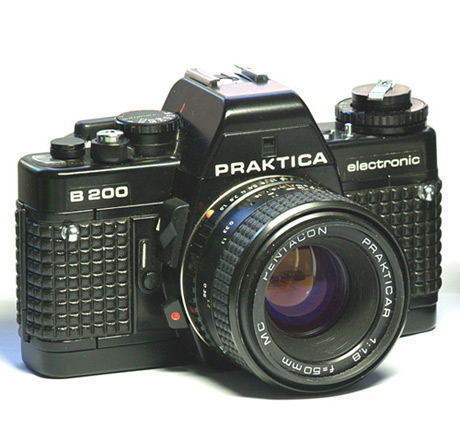
Praktica FX (1952-1954)
When I was a teenager this Praktica was one of the "better" cameras we owned and I was allowed to use it. With it I shot quite a lot of 135 cartridges b/w film. When taking color pictures became financially possible it also ate Agfacolor film.
A good partner to this FX was an Ikophot exposure meter. Perhaps FX made me a bit crooked. Because of the waist level viewfinder I saw the world through the mirror. Left was right and right was left. The camera has no prism to turn the view right way.
No, I am kidding, Praktica was not in my hands all the time. A thirteen years old boy has also plenty of other kind of possibilities to have fun.
Praktica is equipped with a mechanical, horizontal run cloth-blind shutter. Film transfer is carried out with a wheel. Exposure times are a little odd, B, 1/2, 1/5, 1/10, 1/25, 1/50, 1/100, 1/200 and 1/500. The lens is Carl Zeiss Jena Tessar, 2,8/50, for M 42x1 lens mount. Not a bad piece of glass at all. Fixed waist-level viewfinder is added with a simple "sport" viewfinder . After shooting the pic the mirror stays up. No self timer but a flash contact. An excellent camera to learn how to take pictures. At least it helps you to understand the meaning of those automatic features of modern cameras.
Perhaps the best feature of the detachable back is to make more convenient to change it to a data back or a bigger film magazine etc. Praktica has no such option, therefore I can not tell you any Practical reason for that, except the lower price without a hinge. For me that feature has mostly inflicted rattling and stooping.
Mike's Praktica Home |
 |
|
|
|
 Praktica B 200 (1979-1982)
Praktica B 200 (1979-1982)
Praktica B 200 is the first model in Praktica B series cameras which was introduced in Photokina 1978. It has an aperture-priority automatic exposure system when fitted with its own lenses. Metal focal plane shutter is electronically controlled, except the max X - sync speed 1/90 sec which is mechanical. Lens mount is Praktica bayonet mount and the camera has a motor winder connection. Power source is 6V Mallory PX 28 or equivalent. When the battery is exhausted the shutter automatically defaults to mechanical 1/90 sec speed.. Body dimension are W138mm x H87,5mm x D49mm. Body weight is 530g without battery.
"The PRAKTICA B 200 is a fully automatic compact reflex camera with infinitely variable electronic shutter speed control vvithin a speed range from 1/1000 sec. to 40 sec. Shutter speeds of any duration at B setting are electronically controlled. Through the electronic diaphragm-value transmission from the lens into the camera the internal metering can be made at open aperture so that the vievvfinder image always remains at the brightest.
All data vvhich are of importance for exposing are signalled by light-emitting diodes at the right hand edge of the vievvfinder, e.g. the shutter speed to be expected, boundary values and automatic and semi-automatic modes, resp. Besides this, also the preselected dia-phragm numeral is reflected into the lovver edge of the vievvfinder image. For intentional over- and underexposures the automatic mode can be manually corrected. Being equipped with the PRAKTICA bayonet, the PRAKTICA B 200 offers a completely new and rapid lens connection."
With these features B 200 could have been categorized as a high end camera in 1979. On the other hand the plastic material and a plastic look was not especially attractive. |

Praktica MTL 50 (1985 - 1989)
Thirty years younger (than FX) MTL 50 has vertical-moving metal-blade focal plane shutter B, 1/1, 1/2, 1/4, 1/8, 1/15 1/30, 1/60, 1/125, 1/250,1/500, 1/1000 , integrated match-LED TTL-metering , ASA: 12-1600 (PX 28 or 4 x LR44 battery) , a pentaprism view finder. Focusing screen has a triple sliced, diagonal split image, truncated microprism screen and a groundglass field. Other features are an instant return mirror, front mounted shutter release and a M42 screw mount.
|
 |
Revue ML
What's the difference with the MTL 50? Color, of course and all visible text and lens which is "borrowed" from the Zenit SLR.
The disparity could be seen also in the view finder. Revue ML has a simplier fresnel lens focusing screen with microprism and split-image. Exposure indication is carried out with a match needle istead of LEDs in MTL 50.
X-synchronisation (1/125), accessory shoe at the top of the pentaprism, with coaxial flash socket
Revue is a film line of the Quelle brand. A German mail order company of the Primondo Specialty group. Quelle companies exist today in 15 countries. |
| |




